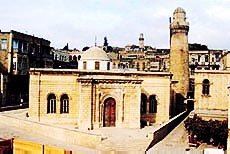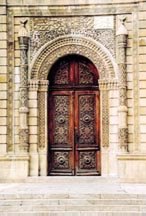|

Winter
1998 (6.4)
Architecture
of the Oil Baron Period
Friday
Mosque
"Inner
City" (Ichari Shahar)
  The original Friday
Mosque was built in 1441-1442 by the Shirvanshah, Khalil-ul-lah
I. Gradually, the mosque fell into disrepair and Haji Sheikhali
Dadashov, a wealthy merchant and shipowner, built a new mosque
on the original site of the old one. His grave is at the entrance
of the mosque. The original Friday
Mosque was built in 1441-1442 by the Shirvanshah, Khalil-ul-lah
I. Gradually, the mosque fell into disrepair and Haji Sheikhali
Dadashov, a wealthy merchant and shipowner, built a new mosque
on the original site of the old one. His grave is at the entrance
of the mosque.
The Friday Mosque in
the "Inner City" (Ichari Shahar) has the most intricate
limestone carvings of the entire city. The mosque was rebuilt
early this century, but the minaret dates to the 15th century.
  The restoration took
place in 1899-1901. The original minaret stands intact beside
the newer building-nearly 500 years separate their construction
dates. The ornate limestone carvings defining the entrance of
the mosque are the most elaborate stone work in the city. The restoration took
place in 1899-1901. The original minaret stands intact beside
the newer building-nearly 500 years separate their construction
dates. The ornate limestone carvings defining the entrance of
the mosque are the most elaborate stone work in the city.
During the Soviet
period, the Friday Mosque was one of the very few religious buildings
that Stalin did not have demolished. Stripped of its religious
functions, the mosque was transformed into the National
Carpet Museum. Since independence (1991),
the mosque is used once again as a place of worship, and the
carpets have been moved into what used to be called the Lenin
Museum parallel to the seaside boulevard.
From Azerbaijan International (6.4) Winter 1998.
© Azerbaijan International 1998. All rights reserved.
Back to Index
AI 6.4 (Winter 1998)
AI Home
| Magazine
Choice | Topics
| Store
| Contact
us
|


